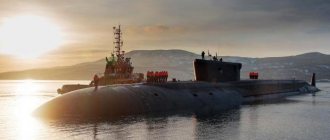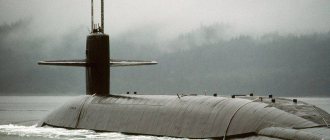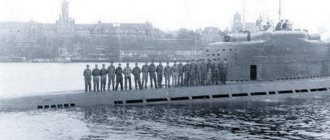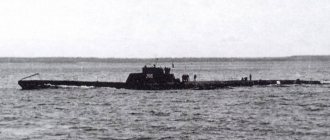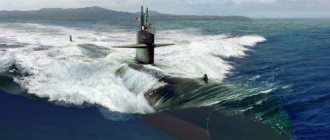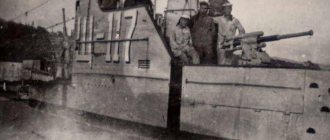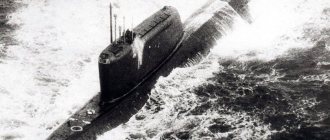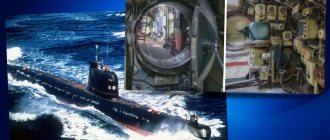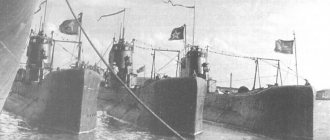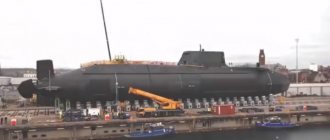Submarines of the "Shch" type "Pike"
Submarines of the "Shch" type ("Pike") are a series of medium-sized submarines built in the USSR in the 1930s - 1940s. Distinctive features of submarines were comparative cheapness to build, increased maneuverability and survivability.
A total of eighty-six submarines of all series were built, including: Series III - four submarines in 1932; series V – twelve submarines in 1933; series V-bis - thirteen submarines in 1933; series V-bis-2 - fourteen submarines in 1933; series X - thirty-two submarines in 1935; series X-bis - thirteen submarines in 1938.
Series III.
The development of the preliminary design of a medium-displacement Series III submarine with torpedo and artillery weapons, called “Pike,” was carried out at NTMK with the participation of submarine shipbuilding specialists B.M. Malinin and K.I. Ruberovsky.
Technical Bureau No. 4 completed the development of the project by the end of 1929. The one-and-a-half-hull (with bulges) submarine of riveted construction was intended for mass construction. Therefore, when developing the project, much attention was paid to reducing its cost in every possible way. It was supposed to replace the block assembly of the submarine in the workshop, in the most favorable conditions to increase labor productivity and reduce costs.
The first version of the design assignment provided for dividing the submarine's durable hull into five compartments. The strength of all light flat bulkheads was designed for only 2 atmospheres. The submarine, in the event of flooding of any compartment, would remain afloat, since its buoyancy reserve (22%) exceeded the volume of the largest of them - the bow. At the same time, calculations have shown that when the bow compartment is flooded, if the adjacent main ballast tank is filled, a trim of over 80 degrees will form. Therefore, the bow compartment was divided into two by an additional bulkhead installed between the torpedo tubes and spare torpedoes. The calculated trim then decreased by about 10 degrees, which was considered satisfactory.
A simplified form of a lightweight hull was adopted, which spanned only two-thirds of the length of the pressure hull. The main ballast tanks were located in the boules (hemispherical fittings) running along the sides, and the bow and stern tanks were located at the ends of the light hull. Only the middle, equalization and rapid immersion tanks were located inside a durable housing. This provided simpler technology, a larger width of the main ballast tanks, and facilitated their assembly and riveting.
However, the Boolean shape of the light hull of a medium submarine worsened propulsion. Tests of the lead submarine of series III showed that at full speed, two systems of transverse waves were formed: one was created by the main contours of the hull and extremities, the other by the boules. Consequently, their interference should have increased the resistance to movement. Therefore, the shape of the boules for submarines of this type in subsequent series was improved. Their nasal tip was pointed and raised up to the level of the waterline. This shifted the entire system of transverse waves generated by the boules somewhat forward, further from resonance with the waves from the main body. For Series III submarines, a straight stem was adopted. In subsequent series of submarines of this type, it was replaced by an inclined, curved one.
In the final version, the robust hull of type III submarines was divided into six compartments by flat bulkheads:
— the first (bow) compartment is a torpedo compartment. It housed four torpedo tubes (two each vertically and horizontally) and four spare torpedoes on racks;
— the second compartment is the battery. In the pits, covered with a removable flooring made of wooden panels, two groups of AB were located (56 elements each, type KSM). In the upper part of the compartment there were living quarters, under the battery pits there were fuel tanks. - the third compartment is the Central Post, above it there was a strong wheelhouse, closed by a fence with a bridge.
— in the fourth compartment two four-stroke uncompressor diesel engines of 600 hp each were placed. with its own mechanisms, systems, gas valves and devices. — the fifth compartment was occupied by two main propeller electric motors of 400 hp each. and two economic propulsion motors of 20 hp each, which were connected to two propeller shafts by an elastic belt transmission, which helped reduce noise. In the sixth (aft) compartment there were two torpedo tubes (located horizontally). In addition to torpedo armament, the submarine had a 37 mm semi-automatic anti-aircraft gun and two 7.62 mm machine guns.
During the construction of the first Shch type submarines, not enough attention was paid to the phenomenon of compression of the hull by external water pressure. The structure in the area where the fillet joins the strong body was reinforced with additional removable beams. There were no deck tanks on the Shch type submarines, and this further increased their desire to bury them. Only later did it become obvious that such a phenomenon is inevitable for all submarines on the surface and is caused by their small reserve of buoyancy. But, when creating the first series of submarines, they tried to combat this by increasing the buoyancy of the bow. For this purpose, a special “buoyancy tank” was installed, filled, like the entire superstructure, through scuppers (holes with grates), but equipped with ventilation valves for the bow main ballast tank. However, this only led to a reduction in the period of pitching and an increase in its amplitude: after a sharp rise to the wave, the bow of the submarine also sharply fell down and buried itself in its sole. Therefore, later the bow “buoyancy tanks” were eliminated.
The main ballast tanks were filled with sea water by gravity through seacocks located in special enclosures in the lower part of the light hull. They had only manual drives. The ventilation valves of these tanks were controlled using both pneumatic remote actuators and manual actuators.
Excessive simplification and the desire to reduce the cost led to the decision to abandon the blowing of the main ballast tanks with turbochargers on Series III submarines, replacing the blowing with pumping with centrifugal pumps. But this replacement turned out to be unsuccessful: the duration of the process of removing the main ballast increased to twenty minutes. This was absolutely unacceptable, and turbochargers were again installed on the Shch type submarines. Later, on all submarines of this type, for the first time in the domestic submarine shipbuilding, blowers were replaced by blowing the main ballast with exhaust gases of diesel engines (low pressure air system). In this case, diesel engines were driven by the main propeller electric motor and acted as a compressor.
Three series III submarines (“Pike”, “Perch” and “Ruff”) were laid down on February 5, 1930. The first two submarines entered service with the Baltic Sea Naval Forces on October 14, 1933. The third submarine entered service with the Baltic Fleet on November 25, 1933. The fourth submarine of series III (Komsomolets) was laid down on February 23, 1930, launched on May 2, 1931, received from industry on August 15, 1934, and enlisted in the Baltic Fleet on August 24.
Tactical - Technical Data
submarines type "Shch" III series:
Displacement: surface / underwater - 572/672 tons. Main dimensions: length 57 meters, maximum width - 6.2 meters, draft on the surface - 3.76 meters. Powerplant: two 38V8 diesel engines with 600 hp each; two PG-8 propulsion engines with a power of 400 hp, two propellers. Fuel reserve - normal - 23.4 tons, full - 52 tons Full surface speed - 11.5 knots, full underwater speed - 8.5 knots. Surface cruising range at full speed - 1,350 miles (9 knots); cruising range above water economic speed - 3,130 miles (8.5 knots); cruising range underwater economic speed - 112 miles (2.8 knots). Autonomy: normal - 20 days, maximum - 40 days. Working diving depth: 75 meters. Maximum diving depth: 90 meters. Buoyancy reserve: 22%. Armament: 4 bow and 2 stern 533-mm torpedo tubes, ammunition - 10 torpedoes, one 45/46 artillery mount 21-K (500 45-mm rounds); one 45 mm gun (500 rounds). Crew: 41 submariners.
Project 971 "Pike-B" - nuclear submarines
The nuclear submarine pr. 971 (code "Bars") was developed at SPMBM "Malachite" under the leadership of G.N. Chernyshova. It belongs to the third generation PLA and is multi-purpose in the full sense of the word. It is designed to search, detect and track enemy SSBNs and AUGs, destroy them with the outbreak of hostilities, as well as strike coastal targets. If necessary, the boat can carry mines.
Series V
On Series III submarines, the strength of the bulkhead between the first and second compartments was designed, like other bulkheads, to withstand an underwater accident. But the method of approximate calculation that was used did not take into account the possible re-deepening of the submarine when moving with trim. Therefore, on submarines of the Sh type of the V series, another transverse bulkhead was added (on the 31st frame), dividing the second compartment into two. As a result, the battery groups were isolated from one another, which increased the survivability of the battery. At the same time, the aft bulkhead of the bow compartment was moved two spacings forward (from the 24th to the 22nd frame).
It should be noted that electric welding was used in the manufacture of intercompartment bulkheads. It was also used in the manufacture of some tanks and foundations of individual mechanisms inside a durable housing. The total number of compartments for V-series submarines has increased to seven. However, it was necessary to store spare torpedoes without charging compartments in the second compartment; to assemble them before firing from torpedo tubes on the left side (No. - 2 and No. - 4), use an oval bulkhead door along the axis of the torpedo tubes on the starboard side (No. - 1 and No. — 3) make appropriate hatches in the new bulkhead.
The middle tank was moved into the double-hull space, which made it easier to design, increasing the test pressure threefold. These design changes were also dictated by the need to transport Shch type submarines to the Far East. Therefore, at the same time, the cutting of the skin and the set of a durable hull were changed, which was made of eight sections corresponding to the railway dimensions.
The length of the V series submarines was increased by 1.5 meters, resulting in a slightly increased displacement. This was also facilitated by the installation of a second 45-mm gun and a doubling of ammunition (up to 1000 shells).
The durable hull of submarines of the Shch type was located between 14 and 75 frames, the distances between which were unequal: from 14 to 16-500 mm, from 16 to 64-750 mm, from 64 to 75-500 mm. Over the course of frames 22 to 63, it was a pipe with circular sections. In the area from 14 to 22 and from 63 to 75 frames, the sections of the strong hull had an elliptical shape, with the bow having a vertical main axis and the stern having a horizontal main axis. The largest diameter of the strong hull at the midship frame is 4.38 meters. The sheathing of the durable hull was made of steel sheets 13.5 mm thick, applied in the longitudinal direction and connected overlapping along the grooves, and connected at the joints by strips. There was a three-row staggered rivet seam along the grooves, and a two-row one along the joints.
The robust housing was designed for an external pressure of 9 atmospheres, corresponding to a depth of about 90 meters. From the bow and stern, the strong hull was limited by waterproof flat bulkheads of riveted construction with a thickness of 16 mm. The torpedo tubes were connected to the trim tank bulkheads and formed part of the pressure hull structure.
Six welded bulkheads divided the robust hull into seven compartments. The lining angles were riveted both to its plating and to the bulkheads; fastening the beams to the sheathing is done by welding. The bulkhead consisted of 22 frames - made of 44 mm sheets in the middle and 11 mm at the edges - supported by vertical posts and a chain box. The remaining bulkheads had a thickness of 11 mm (designed for a pressure of 2 atmospheres), forming the Central Post - 14 mm (designed for 6 atmospheres on both sides).
The unsinkability of submarines on the surface, for cases of navigation without fuel, was ensured by seven waterproof compartments in the onboard ballast tanks. If any compartment of the pressure hull with the adjacent onboard tank on one side was damaged (with the exception of the sixth compartment), as well as if one of the end tanks was damaged, the submarine could remain on the surface with positive stability and maintain speed. Unsinkability in case of an accident in a submerged position was not ensured. The strong deckhouse was located between 40 - 44 frames and was made of low-magnetic steel in the form of a cylinder with an internal diameter of 1,700 mm. The cabin body was made up of two 12-mm sheets connected to each other by squares with spacers between them made of leaded canvas. The cabin roof is spherical, with a sphere radius of 1,770 mm, made of sheets 16 mm thick; it had a hole with a diameter of 650 mm for the coaming of the entrance hatch. The superstructure ran the entire length of the submarine; its maximum width is 1,750 mm, the height in the area where the cylindrical part of the durable body is located is 750 mm. The thickness of the side plates and the upper deck of the superstructure is 3 mm, the distance between the frames is 500 mm. To quickly fill the superstructure with water when its sides are immersed, from 22 to 31 frames in the bow and from 58 to 70 frames in the stern did not reach the strong hull by 5 mm, forming constantly open longitudinal scuppers. Ventilation of the superstructure when filling it with water was carried out through a large number of drilled holes in the deck.
The wave-cut shields of the bow torpedo tubes (the upper ones are 3,040 mm long, the lower ones are 2,790 mm long) were made of 8-mm steel. Due to the design features of the bow, breakwater shields on submarines broke more often during the war than on other types.
A box-section keel made of 10-mm sheets, riveted to the strong hull with squares, was located in the middle part of the hull (frames 14-69) and served to strengthen its longitudinal strength, as well as to place the submarine on keel blocks during docking. To increase stability, portable solid ballast (usually pig iron) with a total weight of up to 37 tons was placed in the keel. In order to reduce water resistance during underwater passage, the durable wheelhouse had a lightweight fence made of 3-mm steel sheets. The fencing deck, located at the coaming level of the wheelhouse hatch, served as a navigation bridge during surface navigation - a magnetic compass and a vertical rudder control post were installed on it.
Aft of the wheelhouse, in the enclosure, there was an above-water latrine and a room for the boatswain's equipment. Free filling and drainage of the fence during immersion and ascent was ensured by holes in its side walls and in the deck. In the area where the stern gun was located, the bulwark of the fence had parts that could be folded down using a hand winch. In the lowered position, they served as a platform for the gun crew. On some submarines during the war they were removed and replaced with a round platform with railings or with permanent tubular railings. The underwater and surface anchors were pulled out with an electric capstan. Hall's surface anchor weighed 600 kg, and the underwater mushroom anchor weighed 1,000 kg.
Tactical - Technical Data
submarines type "Shch" V series:
Displacement: surface / underwater - 585/700 tons. Main dimensions: length 58.5 meters, maximum width - 6.2 meters, draft on the surface - 3.8 meters. Powerplant: two 38V8 diesel engines with 600 hp each; two PG-8 motors with a power of 400 hp, a KSM-2 battery (two groups of 56 elements each), two propellers. Fuel reserve - normal - 23.4 tons, full - 52 tons Full surface speed - 11.9 knots, full underwater speed - 8.5 knots. Surface cruising range at full speed - 1,150 miles (9 knots); cruising range above water economic speed - 2,300 miles (8.5 knots); underwater cruising range at economic speed - 100 miles (2.8 knots). Autonomy: 20 days. Working diving depth: 75 meters. Maximum diving depth: 90 meters. Buoyancy reserve: 20%. Armament: 4 bow and 2 stern 533-mm torpedo tubes, ammunition - 10 torpedoes, one 45/46 artillery mount 21-K (500 45-mm rounds). Crew: 40 submariners.
Project 971 "Pike-B" - nuclear submarines
The nuclear submarine pr. 971 (code "Bars") was developed at SPMBM "Malachite" under the leadership of G.N. Chernyshova. It belongs to the third generation PLA and is multi-purpose in the full sense of the word. It is designed to search, detect and track enemy SSBNs and AUGs, destroy them with the outbreak of hostilities, as well as strike coastal targets. If necessary, the boat can carry mines.
Series V bis
The series included thirteen submarines. Of these, eight were built for the Pacific Fleet, two for the Baltic, and 3 for the Black Sea. The series was originally designated VII.
The power of the main diesel engines was increased by 35%, while the weight and dimensions remained virtually unchanged. The shape of the rudders was also improved, which made it possible to increase the surface speed by 1.5 knots. Based on operating experience of the V series, improvements were made to individual parts and mechanisms. Changing the shape of the deckhouse fence and superstructure did not have a significant effect. In 1934, a proposal was developed to equip submarines of the "Sh" type with dynamos - rocket-propelled guns of 102 mm caliber on series III and 152.4 mm on series V. On May 20, 1934, the tactical and technical specifications for retrofitting submarines of the "type" were approved. Shch" series V into transport submarines for refueling seaplanes. Each converted submarine was required to carry 6 tons of aviation gasoline and 480 liters of oil in 16-liter cans, which was enough to refuel three P-6As or seven ICBM-4s. The system was supposed to be dismantled and used only during special operations.
Tactical - Technical Data
submarines type "Shch" V-bis series:
Displacement: surface / underwater - 601/722 tons. Main dimensions: length 58.0 meters, maximum width – 6.2 meters, draft on the surface – 3.91 meters. Powerplant: two 38V8 diesel engines with 600 hp each; two PG-8 motors with a power of 400 hp, a KSM-2 battery (two groups of 56 elements each), two propellers. Fuel reserve - normal - 23.4 tons, full - 52 tons Full surface speed - 12 knots, full underwater speed - 8.0 knots. Surface cruising range at full speed - 2,960 miles (7 knots); underwater cruising range at economic speed - 100 miles (2.0 knots). Autonomy: 20 days. Working diving depth: 75 meters. Maximum diving depth: 90 meters. Buoyancy reserve: 20%. Armament: 4 bow and 2 stern 533-mm torpedo tubes, ammunition - 10 torpedoes, one 45/46 artillery mount 21-K (500 45-mm rounds), one 12.7-mm DShK machine gun. Crew: 40 submariners.
Characteristics with comparative analysis
Project 971 Shchuka-B submarines were able to outperform similar-class deep-sea cruisers. The Russian third-generation K-284 submarine has been repeatedly compared to the fourth-generation American-made Virginia and Seawolf submarines, rather than to the competing type, the Improved Los Angeles.
One of those who claimed that the Shchuka-B nuclear submarine corresponded to a higher class was Admiral Jeremy M. Boorda.
While in the leadership position of the US Navy from 1994-1996, he emphasized that the ships of the American fleet admitted their powerlessness to detect the Russian Project 971 nuclear submarine; it moved so silently at a speed of 7-9 knots that it can be safely ranked among the fourth generation submarines.
The third generation of Project 971 can quietly bypass the SOSUS submarine locating system.
| Los Angeles | Pike-A | Shchuka-B | Barracuda | Condor | Fin | Ryuby | |
| A country | USA | USSR | Russia | USSR | Russia | USSR | France |
| date of manufacture | 1972-96 | 1976-92 | 1983/2009 | 1979-87 | 1986-93 | 1978-83 | 1976-83 |
| Date of service | 1976- | 1977- | 1984- | 1984- | 1990- | 1983/1989 | 1984- |
| Amount | 62 | 15 | 15 | 2 | 2 | 1 | 6 |
| Speed, knots Surface/underwater | 17 30-35 | 11,7 30 | 11,7 33 | 19 35,2 | 19 35,2 | 11,5 33,5 | 14,9 25,1 |
| Displacement, t Surface Underwater | 6083 7176 | 6991 7252 | 8141 12772 | 5945 9605 | 6472 10400 | 5890 8600 | 2400 2610 |
| Immersion depth, m Standard Critical | 285 455 | 410 610 | 480 600 | 480 550 | 530 600 | 1000 1250 | 350 |
Series V bis - 2
The series included fourteen submarines (five each for the Pacific and Baltic fleets, four for the Black Sea fleet).
The project was developed in the design bureau headed by B.M. Malinin. The tactical and technical data of a submarine of this type changed slightly from series to series in the direction of increasing the power of diesel engines and slightly reducing the cruising range, as well as increasing the underwater speed. The armament (four bow and two stern torpedo tubes, two 45-mm guns) remained unchanged.
The new series of submarines of the "Shch" type received the name V bis-2 series and had a number of significant differences. Once again, the theoretical drawing and shape of the deckhouse were reworked, which increased the surface speed by 0.5 knots and improved seaworthiness. The aft bulkhead of the second compartment was made stepped - this made it possible to store the torpedoes in assembled form. The torpedo loading device was redesigned, which, on the one hand, reduced the clutter of the compartments, and on the other, reduced the loading time to 12 hours. The bulkheads of the Central Post were strengthened (now they could withstand a pressure of 6 kg/cm). Main ballast tanks No. 3 and No. 4 were adapted to receive additional fuel.
The transmission of the economical electric motor was changed from gear to belt, making its operation silent. The electric motors of the bow and stern horizontal rudders were moved to the end compartments, leaving only manual control in the Central Post. The system for blowing the main ballast with diesel engines became standard; the main ballast was purged with a diesel engine, which worked as a compressor.
Type V-bis-2 submarines were armed with ten torpedoes: six in the tubes and four spare ones on racks in the second compartment. Initially these were 533-mm torpedoes type 53-27 (the first number is the caliber in centimeters, the second is the year of adoption), developed at the Ostekhbyuro. Depending on the type, they had a weight of 1,675 or 1,725 kg (explosive weight 200 or 250 kg), a speed of 43.5 knots and a range of 3,700 meters. The main drawback of the 53-27 torpedoes is their poor sealing and inability to withstand the depth regime, so with the start of the war they were completely banned for use in the Black Sea Fleet; they were used very limitedly in other fleets (when the depth was set to at least 3 meters). They were replaced back in 1938 by the 53-38 torpedo, which was a copy of the 53F torpedo purchased in Italy in 1930. The new torpedo, with almost the same length as 53-27 (7,200 and 7,150 mm, respectively), had a weight of 1,615 kg (explosive weight 300 kg) and a speed of 44.5 knots at a range of 4000 meters (there was also a 34.5 knot mode - 8,000 meters or 30.5 knots - 10,000 meters, but it was practically not used on submarines). The 53-38U, 53-39 torpedoes and the ET80 electric torpedo, which entered service during the war, were not used due to size limitations.
Initial artillery armament: - two 45-mm semi-automatic 21K. The horizontal firing angle of each gun is 280°, descent is 10°, elevation is -85°, high-explosive projectile weight is 1.41 kg, initial speed is 760 m/s. Firing range: horizontal - 50 cables, height - 4,500 meters. Rate of fire - about 25-30 rounds per minute. Ammunition - 500 rounds per barrel. For the first shots, a sealed fender for 15 rounds was installed near the semiautomatic device. In the middle part of the bridge there were two swivels for detachable M-1 (Maxim) machine guns, the supply of cartridges for them and for five Mosin rifles was 24,000 pieces). In addition, the submarine had twenty-seven revolvers.
The artillery armament initially caused criticism among the sailors. Converted from the famous 45-mm anti-tank gun, the semi-automatic 21K as an anti-aircraft gun was distinguished by extremely low combat characteristics; its capabilities in combating surface targets were very modest. Firing with armor-piercing incendiary shells had somewhat better results, but overall the 45-mm gun demonstrated completely unsatisfactory combat qualities. Therefore, it is no coincidence that even before the start of the Great Patriotic War, some submarines of the Black Sea Fleet began to receive a 12.7-mm DShK machine gun instead of a stern 45-mm gun.
The “Som” net cutter installed on parts of the submarines was a system of cutters (four on the stem, two on the forecastle linearly elevated and one on each side), as well as a system of guy ropes that protected the protruding parts of the submarine from getting caught by net fence cables. Practice did not confirm the usefulness of this device, and it was gradually dismantled, covering the saw on the stem with metal sheets.
On the eve of the war, the “Crab” device was put into service - an individual protector of submarines from nets and anchor mines. It was installed on brackets on both sides of the wheelhouse fence. It was a pneumatic cutter that automatically cuts through a cable caught in it. A constant problem with this device was the etching of compressed air through the seals, which is why it was often turned off.
The submarines were equipped with two periscopes: a command periscope (PA) and an anti-aircraft periscope (PZ), which initially had a length of 7.5 meters. 9-meter periscopes were used, which submarines received during major overhauls and submarines of earlier releases. Observation was carried out only from the Central Post; lifting and lowering was carried out by a noisy electric winch or manually.
The external communication radio equipment consisted of a long-wave transmitter “Shkval-Shch” and a short-wave transmitter “Bukhta”. Subsequently, they were replaced, respectively, by “Perch” (60-75 W, operating range 200-1200 meters, transmission range with a boat antenna 80-100 miles) and “Pike” (500-650 W, range 30-120 meters, transmission range up to 2,000 miles). Long-wave Dozor and short-wave KUB-4 were used for reception. During repairs, the latter was replaced by “Metel” or 45-PK-1 with increased sensitivity. All devices worked both as a radiotelegraph and as a radiotelephone via a microphone. For intra-squadron communication and communication with landing parties, there was a “Raid” VHF transceiver station (power 4-6 W, transmission range up to 15 miles). Radio direction finders "Burun" and "Passat" were installed on some of the submarines.
Since 1939, submarines began to be equipped with noise direction-finding stations of the “Mars-12” type with an elliptical base of 12 receivers (the receivers were located in the bow permeable tip). Depending on the hydrology of the sea, the station could detect the noise of a large ship at distances of 12.5 - 30 cables, with a direction finding accuracy of 1° to 3°; She did not determine the distance to the target.
For communication with submarines there was a two-sword Vega or Sirius sound-underwater communication installation. Her upper sword was located on the deck between frames 9 and 10, and the lower sword was located in a special enclosure between frames 45 - 46.
The following navigation instruments were installed on the submarines: Sperry gyrocompass (or brand GU M-1 model 2), three 127 mm magnetic compasses (main, track and wheelhouse), electric log GO M-3 model 2, echo sounder EMS-2 and hand lot . Surface illumination at night was provided by an MSPL-L4.0 spotlight.
Initially, the submarine team included seven “middle” commanders (commander, commissar, assistant commander, commanders of BC-1/4, BC-2/3 and BC-5, military paramedic), six junior commanders and twenty-five Red Navy men. In wartime, the size of the team increased to forty people (seven middle and fifteen junior commanders, eighteen Red Navy men).
Autonomy with a normal supply of fuel, oil, fresh and distilled water was 20 days, in some cases it increased to 45-55. Fresh water reserves range from 2.5 to 6.7 tons.
Air purification was carried out by ten electric fans or nine regeneration machines with special RV-2 cartridges (total supply - from 900 to 1,920 pieces) filled with caustic soda. For the same purposes, a special system of twelve steel cylinders with a capacity of 38-40 liters with oxygen compressed to 150 atmospheres was used. The longest continuous stay under water with full use of the entire regeneration system is 72 hours, without use - 12 hours.
A single cabin for the submarine commander, a wardroom, and thirty easily removable beds were arranged for the personnel. On board there were permanent and portable electric heating pads, a steam heating pipeline fed from the shore base to maintain the temperature in the compartments with the hatches closed not lower than +14 °C with outside temperatures down to -20 °C, an electric galley for cooking, electric utensils, two pneumatic underwater latrines and one above-water one in the cabin enclosure, a shower pipeline in the cabin enclosure.
The submarine was equipped with rescue and lifting equipment: eyelets for lifting the submarine using base facilities, reinforced scuppers in the superstructure (for lifting the submarine with soft EPRON pontoons), external and internal equipment for purging compartments and tanks using diving hoses, two signal buoys, four under-keel belts. For the exit of personnel from the sunken submarine, airlock hatches, tubes and a rescue cabin were used; there was also the possibility of exit through torpedo tubes.
Tactical - Technical Data
submarines type "Shch" V-bis-2 series:
Displacement: surface / underwater - 617/721 tons. Main dimensions: length 58.7 meters, maximum width – 6.2 meters, draft on the surface – 4.08 meters. Powerplant: two 38V8 diesel engines with 600 hp each; two PG-8 motors with a power of 400 hp, a KSM-2 battery (two groups of 56 elements each), two propellers. Full surface speed is 11.92 knots, full underwater speed is 6.7 knots. Surface cruising range at full speed - 7,150 miles (5 knots); underwater cruising range - 100 miles (1.8 knots). Autonomy: 20 days. Working diving depth: 75 meters. Maximum diving depth: 90 meters. Buoyancy reserve: 20%. Armament: 4 bow and 2 stern 533-mm torpedo tubes, ammunition - 10 torpedoes, one 45/46 artillery mount 21-K (500 45-mm rounds), one 12.7-mm DShK machine gun. Crew: 37 submariners.
Exploitation
1996 The Bosnian war is in full swing. Serbia is subject to aggression from NATO led by the United States. The Project 971 “Wolf” nuclear boat was on combat watch in the waters of the Mediterranean Sea. The British managed to find direction to the Russian submarine while crossing the Strait of Gibraltar. Coming out of the strait, the submarine disappeared and appeared off the coast of Yugoslavia.
project 971 in winter
The combat mission of the multi-purpose boats "Wolf" and "Panther" of Project 971 was to protect the aircraft-carrying cruiser "Admiral Kuznetsov" from enemy submarines. Performing a protection function, Russian submarines conducted technical surveillance of several foreign submarines, including Los Angeles-class nuclear submarines.
In the same 1996, the Shchuka-B submarine was sent to carry out a combat watch in the waters of the Atlantic Ocean. Unexpectedly, a Russian missile carrier discovered a strategic submarine cruiser of the US Navy. The combat task was set to keep secret surveillance of the combat duty of the American submarine.
This decision was made by the captain himself. The commander of the submarine, A. V. Burilichev, was awarded the title of Hero of the Russian Federation for secretly conducting an operation to spy on SSBNs in the waters of the Atlantic in 1996.
Series X
The main changes and modifications of the X-series Pike-class submarines:
— once again we reworked the theoretical drawing and shape of the deckhouse, which increased the surface speed by 0.5 knots and improved seaworthiness;
— the aft bulkhead of compartment II was made stepped, which made it possible to store torpedoes with attached combat charging compartments (BZO);
— the torpedo-loading device was redesigned, which on the one hand reduced the clutter of the compartments , and on the other, reduced the loading time to 12 hours, versus 25-30 previously;
— the bulkheads of the central post were strengthened to a pressure of 6 kg/cm';
— main ballast tanks No. 3 and No. 4 were adapted to receive fuel;
-the transmission of the economical electric motor was changed from gear to belt, which made the transmission operation silent;
— the electric motors of the bow and stern horizontal rudders were moved to the end compartments, leaving only manual control in the central post;
— the system for purging the main ballast with diesel exhaust gases has become standard;
- new 38K8 diesel engines with a power of 800 hp were installed, which made it possible to increase the surface speed to 14.1 - 14.3 knots;
— to combat torsional vibrations on the propeller shaft line, the friction clutch was replaced with a hydraulic “BD-800/600”, but the effect of this turned out to be limited (one restricted zone remained);
— the high pressure air system has been radically changed;
— emergency blowing of the main ballast began to be carried out with high-pressure air from the distribution columns. Ascent time was reduced from 10 to 3 minutes, rolls disappeared;
— installed a desalination plant with a capacity of 40 liters per hour;
— the design of the muffler was changed, reducing the unmasking “hovering”;
— an oxygen line was added to the air regeneration system, which improved its operation;
- some submarines were equipped with “Crab” net cutters, some had Italian commander’s periscopes type OG-492, with a screw-type electric lifting device.
— the operation of cable winches was made less noisy;
— the fencing of the bow horizontal rudders was made continuous around the entire perimeter.
The series included thirty-two submarines (nine for the Pacific, eight each for the Northern and Black Sea, seven for the Baltic fleet).
New 38K8 diesel engines with a power of 800 hp were installed. at 600 rpm, as a result of which the surface speed theoretically increased to 14.1-14.3 knots.
Tactical - Technical Data
submarines type "Shch" X series:
Displacement: surface / underwater - 584/707 tons. Main dimensions: length 58.8 meters, maximum width – 6.0 meters, draft on the surface – 4.0 meters. Powerplant: two 38K8 diesel engines with 800 hp each; two PG8 motors with a power of 400 hp, a KSM-2 battery (two groups of 56 elements each), two propellers. Full surface speed is 14.0 knots, full underwater speed is 8.3 knots. Surface cruising range at full speed - 2,580 miles (11.5 knots); underwater cruising range - 105 miles (2.6 knots). Autonomy: 20 days. Working diving depth: 75 meters. Maximum diving depth: 90 meters. Buoyancy reserve: 20%. Armament: 4 bow and 2 stern 533-mm torpedo tubes, ammunition - 10 torpedoes, two 45/46 21-K artillery mounts (500 45-mm rounds), two 7.62-mm machine guns. Team: 37-38 submariners.
Project 971 nuclear submarine nuclear submarine “Pike”: implementation
- home
- Tanks
- Armored vehicles
- Military aircraft
- Civil aircraft
- Pistols
- Slot machines
- Machine guns
- Rifles
- Shotguns and carbines
- Artillery
- Helicopters
- Rockets
- Warships
- Submarines
- Aircraft carriers
- Air defense troops
- Grenade launchers
- Military service
- Airsoft guns
- home
- Tanks
- Armored vehicles
- Military aircraft
- Civil aircraft
- Pistols
- Slot machines
- Machine guns
- Rifles
- Shotguns and carbines
- Artillery
- Helicopters
- Rockets
- Warships
- Submarines
- Aircraft carriers
- Air defense troops
- Grenade launchers
- Military service
- Airsoft guns
Series X-bis
The differences from the previous series consist in the abandonment of solutions that did not justify themselves: instead of hydraulic couplings, friction release clutches of the “Bamag” type were installed, the wheelhouse fencing was made of the usual type and higher to better protect the bridge from waves, the first gun was lowered onto the deck, the underwater anchor was removed . The boat's displacement increased by five tons.
On January 17, 1939, a decision was made to build an X-bis series submarine at the Murmansk shipyard of the People's Commissariat of the Fishing Industry. Soon the number of submarines planned for construction increased to two. The leadership of the People's Commissariat of the Fishing Industry proved the lack of the necessary production and personnel base, and the construction of these two submarines was cancelled.
Laid down at plant No. 194 on June 28, 1941, two submarines of the X-bis series received serial numbers 552 - 553. By July 1941, their readiness was 2.7% and 1.7%, by decree of the State Defense Committee of July 10, 1941, their construction was discontinued, on July 23 the submarines were taken out of production and stripped for metal.
Nine X-bis series submarines were completed during the war years, and two were completed after the war.
Tactical - Technical Data
submarines type "Shch" X-bis series:
Displacement: surface / underwater - 589/705 tons. Main dimensions: length 58.8 meters, maximum width - 6.0 meters, draft on the surface - 4.0 meters. Powerplant: two 38K8 diesel engines with 800 hp each; two PG8 motors with a power of 400 hp, a KSM-2 battery (two groups of 56 elements each), two propellers. Full surface speed is 14.0 knots, full underwater speed is 8.3 knots. Surface cruising range at full speed - 2,300 miles (13.2 knots); underwater cruising range - 100 miles (2.5 knots). Autonomy: 20 days. Working diving depth: 75 meters. Maximum diving depth: 90 meters. Buoyancy reserve: 20%. Armament: 4 bow and 2 stern 533-mm torpedo tubes, ammunition - 10 torpedoes, two 45/46 21-K artillery mounts (500 45-mm rounds), two 7.62-mm machine guns. Team: 37-38 submariners.
Submarines of the Shch type actively participated in the Great Patriotic War; out of 44 submarines that fought, thirty-one were killed. Shch type submarines collectively sank 27 enemy transports and tankers with a total displacement of 79,855 GRT, 20 transports and schooners of neutral states (~6500 GRT), and damaged 4 enemy ships (18,204 GRT). The "Shch" type submarines have a combat record of 35% of the enemy's sunk and damaged tonnage.
The Order of the Red Banner was awarded to the submarines Shch-307, Shch-310, Shch-320, Shch-323, Shch-406 of the Red Banner Baltic Fleet, Shch-201, Shch-209 of the Black Sea Fleet, Shch-403, Shch-404, Shch- 421 Northern Fleet.
The submarines Shch-303, Shch-309, the Baltic Fleet, Shch-205, Shch-215 of the Black Sea Fleet, Shch-422 of the Northern Fleet were awarded the Guards rank, the submarine Shch-402 of the Northern Fleet became a Red Banner Guards submarine.
Submarine type "Shch" series III.
Submarine type "Shch" series V.
Submarine type "Shch" series V-bis.
Submarine type "Shch" series V-bis-2.
Submarine type "Shch" series X.
Submarine type "Sh" series X-bis.
Links[edit]
- ↑
Donald Bertke, Gordon Smith, Don Kindell,
World War II Naval Warfare, Volume 4: Germany Sends Russia to the Allies
, page 134 - ↑
Mikhail Monakov, Jurgen Rover,
Stalin's ocean fleet: USSR naval strategy and shipbuilding programs 1935-1953.
, Page 266 - ↑
Donald Bertke, Gordon Smith, Don Kindell,
World War II Naval Warfare, Volume 5: The Air Raid on Pearl Harbor.
This is not an exercise , page 428 - ↑
Donald Bertke, Gordon Smith, Don Kindell,
World War II Naval Warfare, Volume 4: Germany Sends Russia to the Allies
, page 323 - ↑
Mikhail Monakov, Jurgen Rover,
Stalin's ocean fleet: USSR naval strategy and shipbuilding programs 1935-1953.
, Page 265 - ↑
Donald Bertke, Gordon Smith, Don Kindell,
World War II Naval Warfare, Volume 8: Guadalcanal Secured
, page 77 - ↑
Mikhail Monakov, Jurgen Rover,
Stalin's ocean fleet: USSR naval strategy and shipbuilding programs 1935-1953.
, Page 265 - G.F. Krivosheev, Soviet losses and combat losses in the twentieth century
, p. 267 - ↑
Anthony Preston,
Warship 2001-2002.
, Page 70 - Poul Grooss: Naval Warfare in the Baltics, 1939-1945
, p. 62-63, Barnsley, 2022, ISBN 978-1526700001
